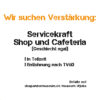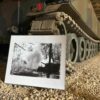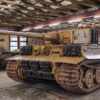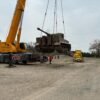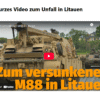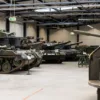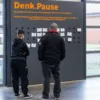To commemorate the liberation of Auschwitz
DO THE JEWS REALLY HAVE TO BE IN THE TANK MUSEUM NOW? BERGEN-BELSEN IS NOT FAR AWAY, THAT’S ENOUGH.
This is (paraphrased) the core sentence of a letter we received in the mid-2010s. The visitor complained eloquently about the fact that in an hour-and-a-half tour through a hundred years of tank technology, the connections between tank weapons, the war of extermination, the Shoah and extermination through labor were also discussed during one of around 25 stops on the tour. He just wanted to see and hear the tank technology and there was really no need for this nonsense about guilt in the tank museum; it would only spoil the fun – and after all, “the subject of Jews is covered enough everywhere”.
I would like to use today’s 80th anniversary of the liberation of the Auschwitz concentration and extermination camp to emphasize once again, on behalf of the Tank Museum, that the topics of the war of extermination, the Shoah and extermination through work undoubtedly belong in the German Tank Museum and are and will remain an integral part of our educational activities. We will defend this conviction with self-confidence and backbone, even against (already announced) political encroachments on our mediation.
These topics will never be a quantitative focus; they will only ever make up a small part of a tour or exhibition. We are neither a memorial site nor a memorial, we are not a historical site and we do not have this topic as a central theme. We only present these topics to the extent that they are related to our main theme, the German tank industry.
And of course they do this in many ways: the most concrete example is the Auschwitz III Monowitz camp, which was liberated 80 years ago. This camp was the only concentration camp built by a company and it served an economic purpose: the artificial production of scarce but important resources, including Buna. This synthetic rubber was used to coat the wheels of German tanks and here we have the first link to the tanks. Another is the use of forced and slave labor to extract resources for the construction of tank parts, their manufacture or their assembly. The industrial and economic history of the German tank industry is therefore closely linked to the thousands of deaths in “extermination through labor”.
At the same time, the tanks were also tools of the war of annihilation – if it is emphasized that the German tank weapon was the spearhead of the German campaigns and the basis for their successes, then it must also be considered in what contexts these successes were achieved. In some areas, the armored units had more to do with the crimes of the Wehrmacht, in others less: soldiers and equipment of the armored divisions were hardly ever used in the mass shootings behind the front, because they were fully utilized as the operational spearhead at the front.
The commissar order, on the other hand, was implemented particularly often in this area – here again, the tank units are over-represented. Paradoxically, old tanks, some still models from the First World War, are over-represented when it comes to partisan warfare in the areas behind the Eastern Front, as it was mostly older soldiers with tanks that were no longer suitable for the front that were supposed to dominate huge areas. In the bloody escalation spiral of this space of violence, the tanks were tools in the “harshest punitive actions”, which often turned into indiscriminate mass shootings of civilians.
We have dozens of “stories about the tanks” ready to make our guided tours and our exhibition varied and interesting – some light and sometimes even funny, many dark and difficult to endure. The connection between German tank building and the war of extermination, the Shoah and extermination through labor are as much a part of it as any other – it’s that simple.
But while we can only rarely or sometimes never tell many stories due to the time of a guided tour or the space in an exhibition, this complex of topics will ALWAYS have a place in our guided tours and in our permanent exhibition.
Because even if it will never be a QUANTITATIVE focus for the reasons mentioned, QUALITATIVE is still something special. The German culture of remembrance quite rightly makes the responsibility for remembering and commemorating this break in civilization one of its cornerstones. Whether other nations remember, come to terms with or even name the genocides and mass murders of their history in the same central way is completely irrelevant. The German decision to centrally commemorate the German breach of civilization is right in itself.
And this culture of remembrance is not about blaming those living today for the Holocaust. It is about remembering, i.e. the shared responsibility of those living today to ensure that what happened is not forgotten and that we and future generations can learn from this knowledge.
The various institutions and mediators can and must play their part in this – and the DPM is doing its small part by constantly, if only briefly, addressing the link between armoring and annihilation.
For the German Tank Museum
Ralf Raths
Scientific Director
News
What’s new with us?
Here we keep you up to date on current exhibitions, exciting new additions to the collection, events and projects relating to the Tank Museum.




